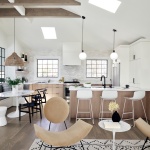
There are several factors to consider when choosing the right type of safety glass for your project. This is especially true when choosing between laminated or tempered glass products, as both options can be ideal depending on one’s plans.
“It’s not always a straightforward decision,” says Marco Ferrazzo, Manager with Artistic Skylights. “Both laminated and tempered glass offer their unique benefits, particularly when it comes to providing an extra layer of safety and security. Choosing between either comes down to application, design requirements, and what kind of external forces it will be up against.”
The difference between laminated and tempered glass
The difference between laminated and tempered glass begins with manufacturing. Laminated glass is produced by using heat and pressure to bond one or two layers of glass together with an “interlayer” of resin (e.g., polyvinyl butyral (PVB)), which serves to make the product more resilient. On the other hand, tempered glass is created through a five-step “toughening process” that involves heating and quick-cooling the glass to trigger rapid hardening.
Certainly, while laminated and tempered glass may look the same, their compositions set them apart. This leads to several other differences that deserve consideration:
- Safety: Both tempered and acrylic glass are considered safety glass options. Upon impact, however, laminated glass is designed to maintain its composition as much as possible, whereas tempered glass “shatters” into small pebble-like shards that pose less risk of cuts to individuals. As such, laminated glass is seen as a “safer” option for applications like windshields, which need to keep vehicle occupants inside the vehicle during a collision, and exterior windows that need to keep individuals out. Tempered glass, meanwhile, may be more ideal in interior applications that need to shatter upon impact to prevent lacerations (e.g., shower doors, dividing walls, etc.).
- Strength: Both tempered and laminated glass are “strong” options for safety glass materials. Laminated owes its strength to its multi-layer composition, and tempered glass earns its resiliency through the tempering process. By and large, tempered glass is often regarded as strong than laminated glass, as its chemical hardening process gives it more protection against breakage.
- Flexibility: Glass cannot be cut once it has been through the tempering process, as doing so may cause a shattering effect. It can, however, be bent to a further degree than laminated. By comparison, laminated glass can be cut and sized without risks to its composition. These attributes make each ideal for various projects.
- Application: Laminated glass is most often used to add layers of security to a building. For example, they are popular in commercial buildings where the goal is to deter forcible entries. Tempered glass is more commonly used in interior safety glass applications.
- Price: Laminated glass carries a much higher price tag due in part to is much more complicated manufacturing process. To meet budgetary restrictions, tempered glass is a great route.
The choice between laminated or tempered glass isn’t cut and dry. As with all product considerations, it pays to discuss the pros and cons of each with a specialist. It is also important at this point to mention that annealed glass should never be used or considered as it breaks into large shards that can cause severe injury.
“There’s no ‘good’ option or ‘bad’ option when it comes to the skylight materials we offer. Each is ideal for various applications and conditions, and our job is to help customers pick what works best for their specific project,” adds Ferrazzo.
Learn about the latest skylight designs and materials for home, office, or industrial properties at visiting Artistic Skylights.



